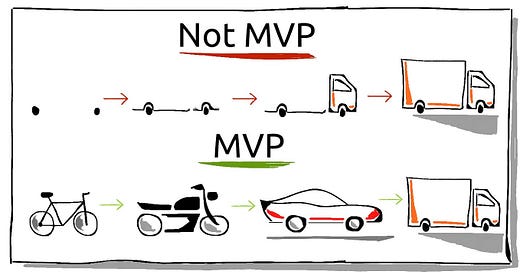The Roadmap to 'Product-Market Fit': Navigating the Journey (...successfully)
Navigate the journey to achieving Product-Market Fit or at least go in the right direction.
Hi, it's Lark! 👋 Welcome to Productainment, your ticket to the world of product mastery. Deep insights on SaaS products, product growth, leadership, and product-market fit - all spiced up with a dash of entertainment. From the do's and don'ts, triumphs and challenges, to everything else that's shaping the product landscape, we've got it covered. Subscribe and step into a thrilling journey through the universe of product innovation. 👇
What Every Startup Is Looking For
Ah, Product-Market Fit (PMF). It's the buzzword for startups, the milestone that every entrepreneur dreams of reaching. But what exactly is it? Simply put, PMF is the point where your product meets a strong market demand and starts to scale sustainably.
It's when customers not only buy your product but also rave about it, becoming your most effective marketers.
However, reaching this coveted stage is easier said than done. Many startups falter, get lost, or even give up before they get there.
The Foundation of The Journey
Before you even think about developing a product, you need to understand the market you're entering.
This involves:
Identifying your target customers
Understanding their pain points
Recognizing the existing solutions (or lack thereof…)
The more you know about the market, the better you can tailor your product to meet its needs.
Start by conducting market research. Surveys, interviews, and focus groups are all great ways to gather information. Don't forget to also look at your competitors. What are they doing right? Where are they falling short? This will give you a clearer picture of the market landscape and help you identify gaps that your product can fill.
The First Steps
Once you have a solid understanding of the market, it's time to brainstorm. Gather your team and throw around ideas that solve the identified pain points. The goal here is to come up with a Minimum Viable Product (MVP)—a simplified version of your product that solves the core problem.
After you've settled on an MVP, build it. But remember, this doesn't have to be a polished, final version of the product. It just needs to be good enough to test your hypothesis. Once it's ready, get it in front of real users.
Collect feedback, observe how they interact with it, note what works and what doesn't, and most importantly: implement these changes.
The Loop of Continuous Improvement
So you've launched your MVP and collected some initial feedback. Now what? Well, it's time to iterate. Take the feedback seriously, make necessary adjustments, and then test again. This is a continuous loop that you'll find yourself in until you hit Product-Market Fit.
Iteration is crucial because it helps you refine your product based on real-world use. It's easy to fall in love with your initial idea, but remember, you're not building this product for yourself. You're building it for your target market. So listen to them, adapt, and improve.
Measuring Your Way to Success
You can't manage what you can't measure. As you iterate, it's essential to track Key Performance Indicators (KPIs) that are relevant to your product and market. These could range from user engagement and retention rates to customer acquisition costs and lifetime value.
By closely monitoring these metrics, you can make data-driven decisions. If a particular feature is causing users to churn, you'll know it's time to revisit the drawing board. On the flip side, if something is working exceptionally well, you can focus more resources on it to accelerate growth.
The Final Frontier
Once you've achieved Product-Market Fit, the next step is scaling. This is where you take your well-received product and grow it to reach a larger audience. But be cautious; scaling too quickly can be just as detrimental as not scaling at all.
The key to successful scaling is maintaining the quality and value that got you to Product-Market Fit in the first place. This often involves building out your team, optimizing your marketing strategies, and possibly even expanding your product line to cater to adjacent markets.
I’ll write a complete series about this topic soon…
The Journey Never Ends
Achieving Product-Market Fit is a significant milestone, but it's not the end of the road. Markets change, customer needs evolve, and competitors emerge. To stay relevant, you'll need to continue iterating, measuring, and adapting.
So there you have it—a “roadmap” to guide you through the journey to Product-Market Fit. It's a challenging, often unpredictable path, but with the right focus, metrics, and a willingness to adapt, you'll increase your chances of getting there successfully.





